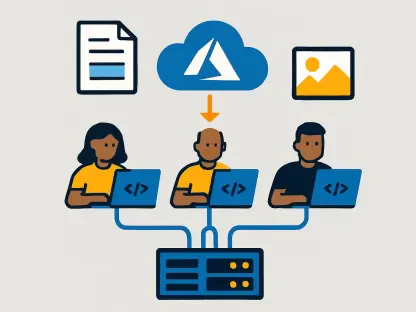As digital transformation accelerates, the cloud has become an indispensable asset for businesses seeking scalability, flexibility, and cost-effectiveness. Amidst the burgeoning cloud ecosystem, data pipelines play a crucial role in orchestrating data flow from sources to destinations. However, the challenges of managing scalable, efficient, and cost-effective pipelines persist. Here, automation emerges as a pivotal solution, offering transformative benefits in optimizing cloud data workflows by enhancing performance, reducing cost, and improving overall system reliability.
The Role of Automation in Data Flow
Streamlining with Advanced Tools
In the complex landscape of cloud-based systems, automating data pipelines is a game-changer, primarily because it streamlines data movement, manages resources more effectively, and lowers operational costs. Tools such as Apache Airflow and Apache Kafka usher in a new era of efficiency. Apache Airflow is well-regarded for orchestrating intricate workflows as Directed Acyclic Graphs (DAGs). These DAGs are essential for scheduling and executing data tasks, significantly enhancing task management and automation. Its notable integration with top cloud providers, including AWS, Google Cloud, and Azure, positions Airflow as a versatile choice for deploying cloud-native applications. On the other hand, Apache Kafka specializes in real-time data streaming, offering low-latency solutions crucial for time-sensitive applications like fraud detection. By leveraging platforms such as AWS MSK, Kafka ensures efficient and swift data processing in real time, thus optimizing data flow.
Balancing Efficiency and Cost
Optimizing data pipelines is not solely about speeding up data flow; it’s also crucial to maintain cost-effectiveness and resource efficiency. Smart allocation of resources and automation tools play an essential role in achieving this balance. Serverless computing exemplifies such an approach, featuring functions like AWS Lambda, Google Cloud Functions, and Azure Functions. These serverless technologies execute code without direct server management, reducing overhead and aligning cost with actual usage due to the pay-per-use model. Additionally, implementing strategies such as data partitioning and lifecycle policies in cloud storage solutions like AWS S3, Google Cloud Storage, and Azure Blob Storage aids in managing vast volumes of data efficiently. This holistic approach ensures streamlined operations while controlling expenditure, a vital factor for businesses leveraging cloud infrastructure.
Advancing Data Pipeline Optimization
Enhancing Performance Through Workflow Orchestration
Workflow orchestration is key to optimizing data pipelines, especially when involving complex interdependencies and multiple operations. Solutions like Apache Airflow and Luigi are instrumental in crafting efficient workflows by automating processes and managing dependencies. Airflow, with its robust scheduling capabilities, ensures tasks are executed in order, handling retries and errors effectively. Meanwhile, Luigi assists in building complex pipelines, emphasizing data dependency and task completion. These orchestration tools improve pipeline reliability and performance, reducing bottlenecks and ensuring the timely processing of data. Parallel processing further boosts efficiency by enabling simultaneous task execution. Utilizing frameworks like Apache Spark on cloud platforms, enterprises can split data processing tasks across nodes, expediting data handling and minimizing latency.
Transitioning from Batch to Stream Processing
The choice between batch and stream processing can significantly affect a pipeline’s efficiency and adaptability. Batch processing is traditionally used for handling large volumes of historical data, running tasks at scheduled intervals. Stream processing, conversely, processes data in real time, offering significant advantages for analytics and applications requiring immediate response. A hybrid approach, merging these methodologies, offers flexibility and optimization benefits. For instance, Kafka can manage streaming data, while Spark serves batch processing needs, creating a dynamic infrastructure capable of scaling tasks and responding promptly to different data requirements. This dual strategy enables businesses to harness the full potential of their data, ensuring informed decision-making and timely insights across operations.
Future of Cloud-Based Data Handling
Leveraging Data Compression and Format Optimization
As data volumes continue to proliferate, adopting efficient storage techniques becomes paramount. One approach is harnessing optimized data formats such as Parquet and ORC, which compress data while maintaining rapid access speeds. The use of these formats can substantially lower storage costs and accelerate query performance, proving invaluable in environments with massive data handling requirements. Additionally, implementing advanced compression techniques not only reduces costs but also enhances the speed of data retrieval and processing. By prioritizing data efficiency at both storage and access levels, organizations can achieve a robust and agile data pipeline system that meets the evolving demands of digital businesses.
Smart Scaling and Resource Allocation
As digital transformation accelerates, businesses are increasingly leveraging the cloud, which offers essential advantages like scalability, flexibility, and reduced costs. Within the rapidly expanding cloud environment, data pipelines serve an integral function. They manage the flow of data from its origin to its final destination. Despite their importance, managing these pipelines to be scalable, efficient, and cost-effective remains challenging. This is where automation steps in as a game-changing solution. Automation can significantly optimize cloud data workflows. By integrating automated processes, businesses can see enhanced performance, reduced costs, and more reliable overall systems. Automation alleviates the burden of manually managing data transfer, enabling organizations to allocate resources more strategically and focus on core business objectives. As the cloud continues to evolve, the use of automation in managing data pipelines will likely become even more critical, ensuring systems remain efficient and adaptable to changing business needs.









